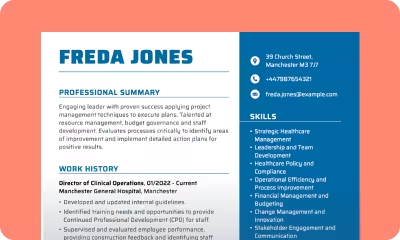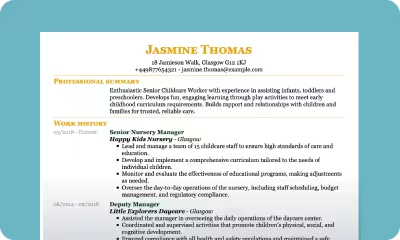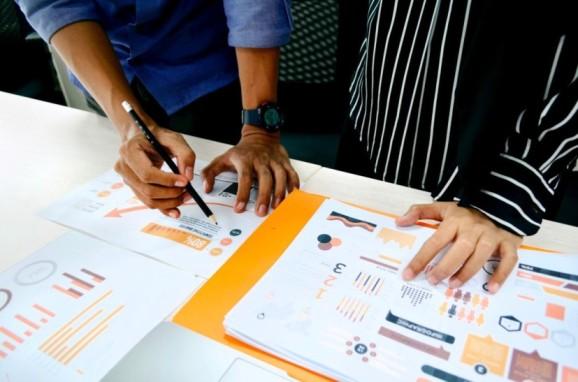Leonardo da Vinci CV
Leonardo da Vinci, a man whose creativity seemed to have no limits. Do you know all his inventions? And did you know that he was the one who introduced the concept of the CV for job applications?

Our customers have been hired by: *Foot Note
Leonardo da Vinci was born in Vinci, Italy, in the year 1452. This period in history is known as the Renaissance, an era of flourishing art and intellect. His genius transcended the boundaries of art, science, and innovation, etching his extraordinary inventions permanently into the annals of history. Little did he know that his insatiable curiosity would lead him to create what we now recognise as the world’s first Curriculum Vitae (CV).
Leonardo da Vinci’s CV concept
Leonardo da Vinci’s life journey was marked by an incessant pursuit of knowledge and mastery. From his early days in Vinci, his diverse talents set him apart.
He was known for being:
- a painter
- sculptor
- architect
- scientist
- mathematician
- engineer
- inventor,
- anatomist,
- writer,
- and philosopher.
Leonardo da Vinci’s intellectual curiosity had no limits. His artistic masterpieces, such as the “Mona Lisa” and the “Last Supper,” remain iconic to this day. However, it is in his notebooks filled with sketches and ideas that the breadth of his genius truly shines. Working across disciplines, da Vinci made contributions ranging from pioneering anatomical studies to designing groundbreaking machines.
With such a scientific background, showcasing his potential without the right means was challenging. This is precisely why, in seeking opportunities to present his skills, da Vinci conceived the idea of creating a document that would encapsulate the essence of his abilities – and this is how the first CV was born.
Circumstances of the creation of the world’s first CV
In his pursuit of exciting opportunities during the Renaissance, Leonardo da Vinci had his eyes set on two influential figures and their respective courts. His main target was Ludovico Sforza, the Duke of Milan. Leonardo wasn’t just looking for a job; he wanted a role at the Milanese court that would let him showcase his talents beyond art. Additionally, he was keen on winning the favour of Lorenzo de’ Medici in Florence.
While he didn’t apply for a specific job title in today’s terms, da Vinci aimed to bring his artistic and intellectual flair to Florence’s cultural scene. In a nutshell, da Vinci wasn’t looking for a 9-to-5; he was on a quest for opportunities that would let him be the Renaissance maestro he was destined to be.
Leonardo da Vinci’s CV
We know that da Vinci got the job. Was it thanks to his impressive CV?
Although it is considered the first CV, it was a meticulously hand-written letter.
This is what it looked like originally:

And what does it say? Here’s the translation
“My Most Illustrious Lord,
Having now sufficiently seen and considered the achievements of all those who count themselves masters and artificers of instruments of war, and having noted that the invention and performance of the said instruments is in no way different from that in common usage, I shall endeavour, while intending no discredit to anyone else, to make myself understood to Your Excellency for the purpose of unfolding to you my secrets, and thereafter offering them at your complete disposal, and when the time is right bringing into effective operation all those things which are in part briefly listed below:
- I have plans for very light, strong and easily portable bridges with which to pursue and, on some occasions, flee the enemy, and others, sturdy and indestructible either by fire or in battle, easy and convenient to lift and place in position. Also means of burning and destroying those of the enemy.
- I know how, in the course of the siege of a terrain, to remove water from the moats and how to make an infinite number of bridges, mantlets and scaling ladders and other instruments necessary to such an enterprise.
- Also, if one cannot, when besieging a terrain, proceed by bombardment either because of the height of the glacis or the strength of its situation and location, I have methods for destroying every fortress or other stranglehold unless it has been founded upon a rock or so forth.
- I have also types of cannon, most convenient and easily portable, with which to hurl small stones almost like a hail-storm; and the smoke from the cannon will instil a great fear in the enemy on account of the grave damage and confusion.
- Also, I have means of arriving at a designated spot through mines and secret winding passages constructed completely without noise, even if it should be necessary to pass underneath moats or any river
- Also, I will make covered vehicles, safe and unassailable, which will penetrate the enemy and their artillery, and there is no host of armed men so great that they would not break through it. And behind these the infantry will be able to follow, quite uninjured and unimpeded.
- Also, should the need arise, I will make cannon, mortar and light ordnance of very beautiful and functional design that are quite out of the ordinary
- Where the use of cannon is impracticable, I will assemble catapults, mangonels, trebuckets and other instruments of wonderful efficiency not in general use. In short, as the variety of circumstances dictate, I will make an infinite number of items for attack and defence.
- And should a sea battle be occasioned, I have examples of many instruments which are highly suitable either in attack or defence, and craft which will resist the fire of all the heaviest cannon and powder and smoke.
- In time of peace I believe I can give as complete satisfaction as any other in the field of architecture, and the construction of both public and private buildings, and in conducting water from one place to another.
Also I can execute sculpture in marble, bronze and clay. Likewise in painting, I can do everything possible as well as any other, whosoever he may be.
Moreover, work could be undertaken on the bronze horse which will be to the immortal glory and eternal honour of the auspicious memory of His Lordship your father, and of the illustrious house of Sforza.
And if any of the above-mentioned things seem impossible or impracticable to anyone, I am most readily disposed to demonstrate them in your park or in whatsoever place shall please
Your Excellency, to whom I commend myself with all possible humility.”
What distinguished Leonardo's CV?
Visual Presentation
Da Vinci’s CV was not merely a list; it was a work of art. It featured sketches and diagrams that adorned its pages. The document presented not only his skills but also the essence of his creativity.
Multifaceted Mastery
In an era of specialists, da Vinci celebrated versatility. His curriculum vitae emphasised his skills in various fields, including painting, sculpture, engineering, and anatomy.
Key Achievements
Leonardo’s timeless CV
As we admire Leonardo da Vinci’s original Curriculum Vitae, it is intriguing to note the similarities between his approach and the CVs we painstakingly create in the 21st century.
While da Vinci’s CV was a handwritten masterpiece, today’s CVs have evolved into digital documents, often following standard CV formats.
Leonardo’s visual elegance, embodied in sketches and artistic flair, finds its modern equivalent in the use of carefully selected fonts, layouts and even digital portfolios.
While da Vinci celebrated multi-faceted mastery, today’s CVs emphasise a mix of technical skills, soft skills and relevant experience, reflecting the need for versatile professionals in our complex working environments.
Furthermore, just as da Vinci’s CV showcased his groundbreaking inventions, our contemporary CV examples often emphasise technological proficiency and design achievements.
Leonardo da Vinci’s CV - Key takeaways
Leonardo da Vinci’s pioneering approach to self-presentation serves as a timeless inspiration, with key elements resonating even in the contemporary landscape of CV writing.
Leonardo da Vinci, born in Vinci, Italy, in 1452, was renowned for his accomplishments in the realms of art, science, and innovation during the Renaissance. He crafted his CV in the Renaissance era, not only showcasing his artistic abilities but also his diverse skills across various disciplines.
His CV was not a conventional list but a visual masterpiece incorporating sketches and diagrams. It highlighted his mastery in painting, sculpture, engineering, anatomy, and beyond, reflecting his versatile talents. Da Vinci’s biography extended beyond traditional achievements, presenting groundbreaking inventions, military strategies, and scientific research. Although considered the first CV, it was a meticulously handwritten letter addressed to Ludovico Sforza, the Duke of Milan.
The emphasis Da Vinci placed on visual artistry aligns with the modern importance of visual appeal in CVs, where design elements and formatting contribute to a visually pleasing presentation. Da Vinci’s inclusion of innovative inventions and achievements resembles contemporary CVs that emphasise not only qualifications but also contributions, projects, and impact.
Da Vinci’s handwritten letter has evolved into digital CVs, reflecting adaptation to technological changes in contemporary professional communication.
Jagoda Jaskowicz
Senior Content Editor, SEO Content Writer
Meet Jagoda Jaskowicz – a certified copywriter, Polish language translator, and seasoned career adviser. Thriving on constant self-improvement, she eagerly stays ahead in her field. With a rich background working with individuals from over 50 countries, Jagoda has successfully completed more than a thousand projects in copywriting and translation.
*The names and logos of the companies referred to above are all trademarks of their respective holders. Unless specifically stated otherwise, such references are not intended to imply any affiliation or association with myperfectCV.










